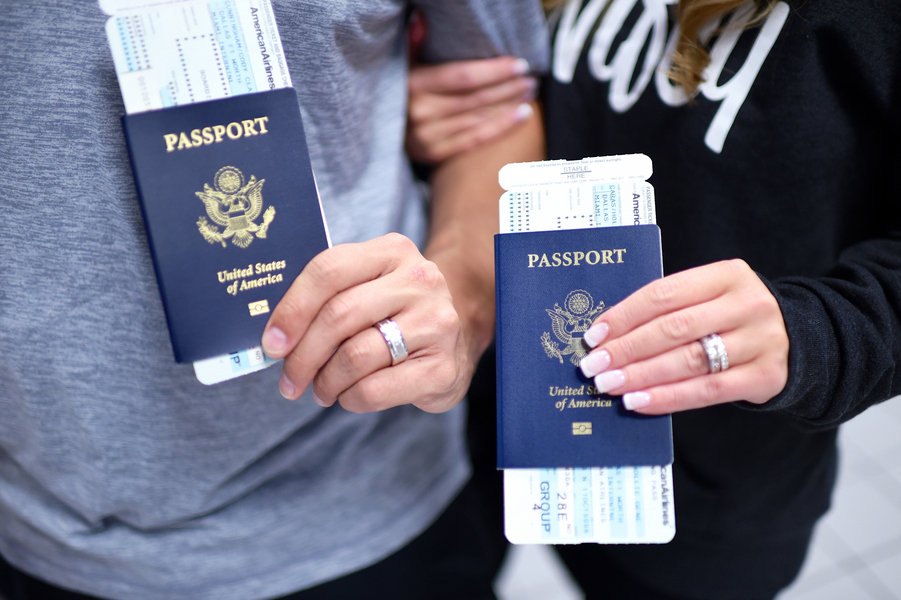Flying to a far-off honeymoon destination? Here's how to feel on top of the world when you arrive.
By: Jenna MahoneyLeaving one time zone and landing in another can put quite a damper on you and your honeymoon. The typical symptoms, including sleepiness, headaches, lethargy and — in extreme cases — nausea, combined with the feeling that you are the only person in outer space, can be a serious drag. Here's how to keep time on your side.

Photo Credit: Fairy Tale Photography
1. Get on Schedule
Before boarding, set your watch to the local time of your destination. In flight, aim to sleep in accordance with that time zone. If you've got an easily adjustable schedule before your trip, try this trick: alter your bedtime. If you are headed west, hit the hay about an hour later for about as many days as time zones you skip. Traveling east? Turn out the lights a little earlier than usual.
2. Eat Right
Long-haul international airlines will serve a main meal about an hour after take-off. Eat it only if you are not changing time zones, since you want to keep your body clock in sync with your destination. For example, skip eating if you take off at 10 p.m. and it's 2 a.m. in Italy, your final destination. Salt is another reason to avoid eating supper. Pre-packaged foods, such as those served on planes, tend to be high in sodium, which can cause bloat, another physical discomfort associated with jet lag. Can't say no? Opt for the pasta; some experts suggest that carb-dense foods can make it easier to sleep. Often just before landing, another meal is served. Opt for a protein-rich selection, as opposed to a carb-packed one, which can cause a flux in energy levels.
Related: How to Stay Healthy on Your Honeymoon
3. Avoid Alcohol
Nothing can tinker with your body clock the way alcohol does. What's more, since it's dehydrating, booze can intensify jet-lag symptoms. And while you're at it, skip drinking caffeine, too. If you must enjoy a cup of tea, bring your own herbal tea bag and ask the flight attendant to heat up some bottled water.
4. Get Moving
Those cartoon exercise videos aren't just for entertainment they also provide good tips for getting the blood moving. Take a few minutes every three hours or so to move around. The increased blood flow may help conquer some symptoms.
5. Upgrade
Wouldn't you prefer to snooze lying down? Consider splurging on a business- or first-class ticket. Some premier classes have private cabins with beds, while many business sections on international flights offer seats that fully recline.No matter where you sit, wear shoes that don’t constrict your feet or ankles (areas that can swell in flight), and consider bringing on your own blanket. Toms shoes are the perfect up-in-the-air solution: They’re lightweight slip-ons that are stylish no matter the situation. A classic White & Warren cashmere travel wrap can be fashioned into a blanket, shawl or scarf.
Related: How to Pack Lighter for Your Honeymoon
6. Buffer Yourselves
If your schedule (and wallet) allow, add bumper days to your itinerary. With a full day to acclimate to the time change, you won't have to lose out on any of the activities you've planned.
Related: 5 Tips for Booking Honeymoon Excursions
7. Drink Up
Allowing yourself to become dehydrated is a big no-no. Dizziness, anxiousness and even back pain can be a result of being both dehydrated and jet lagged. Before your trip, aim to drink a liter of water each day for two weeks. Have as much water as possible both in the air and post-landing. No matter your class, flight crews often offer water and juice at regular intervals over long hauls. If you don’t see them in the cabin, go to the galley, where water stations are usually set up. And don’t drink the tap water — it’s not filtered at best and completely non-potable at worst.
8. See the Light
Research published in the New England Journal of Medicine found that exposure to sunlight can increase vitamin D levels and decrease jet lag. So take a walk if it's still light when you land. It'll feel good to move around a bit and it will also help you adapt to the local time. Eat a small, balanced meal and consider getting a massage. Not only does massage help lessen bloating it can also encourage blood flow to alleviate jet-lag symptoms.






